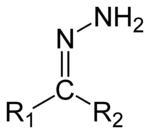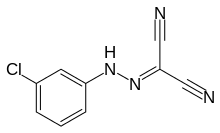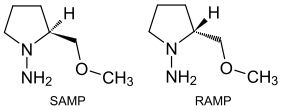Hydrazone
Hydrazones are a class of organic compounds with the structure R
1R
2C=NNH
2.[1] They are related to ketones and aldehydes by the replacement of the oxygen with the NNH
2 functional group. They are formed usually by the action of hydrazine on ketones or aldehydes.[2][3]

Uses
The formation of aromatic hydrazone derivatives is used to measure the concentration of low molecular weight aldehydes and ketones, e.g. in gas streams. For example, dinitrophenylhydrazine coated onto a silica sorbent is the basis of an adsorption cartridge. The hydrazones are then eluted and analyzed by HPLC using a UV detector.
The compound carbonyl cyanide-p-trifluoromethoxyphenylhydrazone (abbreviated as FCCP) is used to uncouple ATP synthesis and reduction of oxygen in oxidative phosphorylation in molecular biology. Phenylhydrazine reacts with glucose to form an osazone.
Hydrazone-based coupling methods are used in medical biotechnology to couple drugs to targeted antibodies (see ADC), e.g. antibodies against a certain type of cancer cell. The hydrazone-based bond is stable at neutral pH (in the blood), but is rapidly destroyed in the acidic environment of lysosomes of the cell. The drug is thereby released in the cell, where it exerts its function.[4]
In aqueous solution, aliphatic hydrazones are 102- to 103-fold more sensitive to hydrolysis than analogous oximes.[5]
Reactions
Hydrazones are reactants in hydrazone iodination, the Shapiro reaction and the Bamford-Stevens reaction to vinyl compounds. A hydrazone is an intermediate in the Wolff–Kishner reduction. Hydrazones can also be synthesized by the Japp–Klingemann reaction via β-keto-acids or β-keto-esters and aryl diazonium salts. The mechanochemical process was used recently as a green one to synthesize pharmaceutically attractive phenol hydrazones.[6] Hydrazones are converted to azines when used in the preparation of 3,5-disubstituted 1H-pyrazoles,[7] a reaction also well known using hydrazine hydrate.[8][9] With a transition metal catayst, hydrazones can reaction with various electrophiles.[10]
N,N-dialkylhydrazones
In N,N-dialkylhydrazones[11] the C=N bond can be hydrolysed, oxidised and reduced, the N-N bond can be reduced to the free amine. The carbon atom of the C=N bond can react with organometallic nucleophiles. The alpha-hydrogen atom is more acidic by 10 orders of magnitude compared to the ketone and therefore more nucleophilic. Deprotonation with for instance LDA gives an azaenolate which can be alkylated by alkyl halides, a reaction pioneered by Elias James Corey and Dieter Enders in 1978.[12][13] In asymmetric synthesis SAMP and RAMP are two chiral hydrazines that act as chiral auxiliary with a chiral hydrazone intermediate.[14][15][16]
Gallery
- Hydrazones
 Benzophenone hydrazone, an illustrative hydrazone
Benzophenone hydrazone, an illustrative hydrazone
 Gyromitrin (Acetaldehyde methylformylhydrazone), a toxin
Gyromitrin (Acetaldehyde methylformylhydrazone), a toxin Dihydralazine, an antihypertensive drug
Dihydralazine, an antihypertensive drug
References
- March, Jerry (1985), Advanced Organic Chemistry: Reactions, Mechanisms, and Structure (3rd ed.), New York: Wiley, ISBN 0-471-85472-7
- Stork, G.; Benaim, J. (1977). "Monoalkylation of α,β-Unsaturated Ketones via Metalloenamines: 1-butyl-10-methyl-Δ1(9)-2-octalone". Organic Syntheses. 57: 69.; Collective Volume, 6, p. 242
- Day, A. C.; Whiting, M. C. (1970). "Acetone hydrazone". Organic Syntheses. 50: 3.; Collective Volume, 6, p. 10
- Wu, Anna M.; Senter, Peter D. (7 September 2005). "Arming antibodies: prospects and challenges for immunoconjugates". Nature Biotechnology. 23 (9): 1137–46. doi:10.1038/nbt1141. PMID 16151407.
- Kalia, J.; Raines, R. T. (2008). "Hydrolytic stability of hydrazones and oximes". Angew. Chem. Int. Ed. 47 (39): 7523–6. doi:10.1002/anie.200802651. PMC 2743602. PMID 18712739.
- Oliveira, P. F. M.; Baron, M.; Chamayou, A.; André-Barrès, C.; Guidetti, B.; Baltas, M. (2014). "Solvent-free mechanochemical route for green synthesis of pharmaceutically attractive phenol-hydrazones" (PDF). RSC Adv. 4 (100): 56736–56742. doi:10.1039/c4ra10489g.
- Lasri, Jamal; Ismail, Ali I. (2018). "Metal-free and FeCl3-catalyzed synthesis of azines and 3,5-diphenyl-1H-pyrazole from hydrazones and/or ketones monitored by high resolution ESI+-MS". Indian Journal of Chemistry, Section B. 57B (3): 362–373.
- Outirite, Moha; Lebrini, Mounim; Lagrenée, Michel; Bentiss, Fouad (2008). "New one step synthesis of 3,5-disubstituted pyrazoles under microwave irradiation and classical heating". Journal of Heterocyclic Chemistry. 45 (2): 503–505. doi:10.1002/jhet.5570450231.
- Zhang, Ze; Tan, Ya-Jun; Wang, Chun-Shan; Wu, Hao-Hao (2014). "One-pot synthesis of 3,5-diphenyl-1H-pyrazoles from chalcones and hydrazine under mechanochemical ball milling". Heterocycles. 89 (1): 103–112. doi:10.3987/COM-13-12867.
- Wang, H; Dai, X.-J.; Li, C.-J. (2017). "Aldehydes as alkyl carbanion equivalents for additions to carbonyl compounds". Nature Chemistry. 9: 374–378. doi:10.1038/nchem.2677.
- Lazny, R.; Nodzewska, A. (2010). "N,N-dialkylhydrazones in organic synthesis. From simple N,N-dimethylhydrazones to supported chiral auxiliaries". Chemical Reviews. 110 (3): 1386–1434. doi:10.1021/cr900067y. PMID 20000672.
- Corey, Elias James; Enders, D. (1976). "Applications of N,N-dimethylhydrazones to synthesis. Use in efficient, positionally and stereochemically selective C_C bond formation; oxidative hydrolysis to carbonyl compounds". Tetrahedron Letters. 17 (1): 3. doi:10.1016/S0040-4039(00)71307-4.
- Corey, E. J.; Enders, D. (1978). "Herstellung und synthetische Verwendung von metallierten Dimethylhydrazonen Regio- und stereoselektive Alkylierung von Carbonylverbindungen". Chemische Berichte. 111 (4): 1337–1361. doi:10.1002/cber.19781110413.
- Enders, D.; Eichenauer, H. (1977). "Enantioselective alkylation of aldehydes via metalated chiral hydrazones". Tetrahedron Letters. 18 (23): 191–194. doi:10.1016/S0040-4039(01)92585-7.
- Enders, Dieter; Fey, Peter; Kipphardt, Helmut (1987). "(S)-(−)-1-Amino-2-methoxymethylpyrrolidine (SAMP) and (R)-(+)-1-amino-2-methoxymethylpyrrolidine (RAMP), versatile chiral auxiliaries". Organic Syntheses. 65: 173.; Collective Volume, 8, p. 26
- Enders, Dieter; Kipphardt, Helmut; Fey, Peter (1987). "Asymmetric syntheses using the SAMP-/RAMP-hydrazone method: (S)-(+)-4-methyl-3-heptanone". Organic Syntheses. 65: 183.; Collective Volume, 8, p. 403


